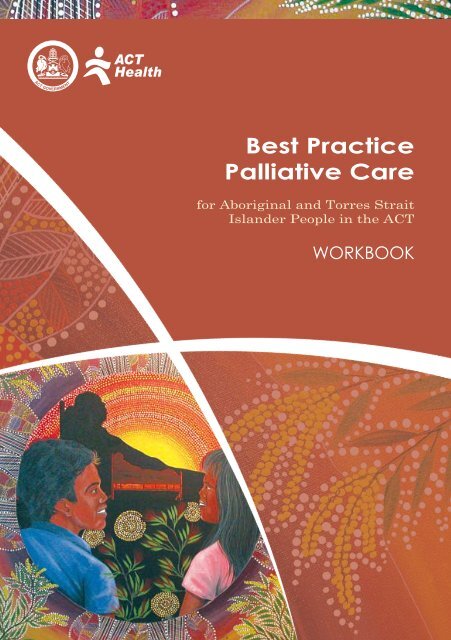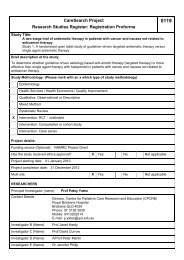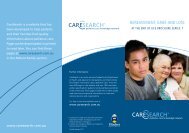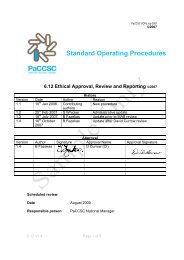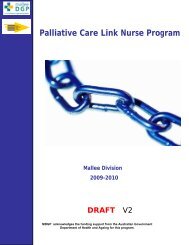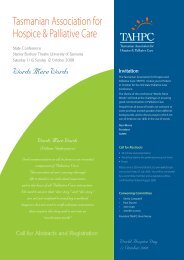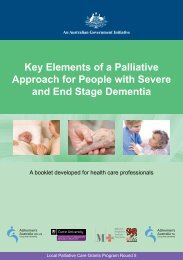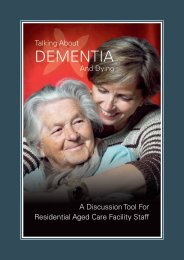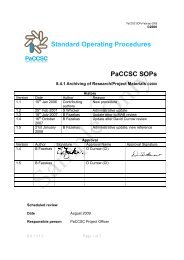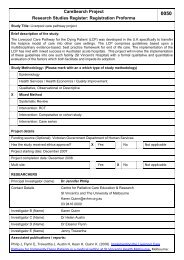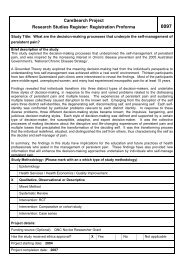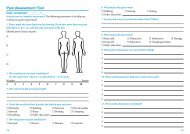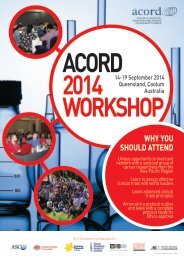Best Practice Palliative Care Workbook (937kb pdf doc) - CareSearch
Best Practice Palliative Care Workbook (937kb pdf doc) - CareSearch
Best Practice Palliative Care Workbook (937kb pdf doc) - CareSearch
Create successful ePaper yourself
Turn your PDF publications into a flip-book with our unique Google optimized e-Paper software.
<strong>Best</strong> <strong>Practice</strong><strong>Palliative</strong> <strong>Care</strong>for Aboriginal and Torres StraitIslander People in the ACTWORKBOOK
ContentsAcknowledgements............................................................................................2Introduction..........................................................................................................3Improving access to services.............................................................................4Checklist................................................................................................................6Communications........................................................................................6<strong>Care</strong> Management......................................................................................8Bereavement and Grief............................................................................ 10Diversity of Aboriginal and Torres Strait Islander Culture...........11Be Flexible.................................................................................................. 12Ongoing References................................................................................. 13Communicating with Aboriginal and Torres Strait .Islander clients requiring palliative care.....................................................14Local services/contacts for Aboriginal and Torres Strait .Islander <strong>Palliative</strong> <strong>Care</strong> Clients..................................................................... 16Notes..................................................................................................................... 17
AcknowledgementsThank you to the many Aboriginal and Torres Strait Islander healthworkers who have provided valuable input to the development of theworkbook and associated posters and brochures.We would also like to thank Mr Dale Huddleston (Wiradjuri/Ngandi) andMr Dean Keed for the artwork used through this workbook.Concept: The art shows palliative care in a warm, kind, sharingenvironment where Aboriginal people should be encouraged to visit andfeel comfortable.Mr Huddleston has requested that the artwork continue to be used only inrelation to this project.Copies of the National Resource Kit can be obtained from:Rural Health and <strong>Palliative</strong> <strong>Care</strong> Branch.Australian Government Department of Health and Ageing.Phone: 1800 020 787.Website: www.palliativecare.gov.au
IntroductionThis <strong>Workbook</strong> has been developed to provide an ACT specificcomplementary resource to the national “Providing culturally appropriatepalliative care to Indigenous Australians – Resource Kit”. The Resource Kitaims to support palliative care professionals in the provision of culturallyappropriate and safe palliative care to Indigenous Australians.The workbook is an integral part of the nationally funded “CommunityAwareness Raising of Indigenous <strong>Palliative</strong> <strong>Care</strong> <strong>Practice</strong> Principles – ACT”.This Project also aims to raise awareness of palliative care in the ACTAboriginal and Torres Strait Islander community through the provision ofpromotional posters and brochures.The provision of a quality, appropriate palliative care response to the needs ofIndigenous Australians is a focus under the National <strong>Palliative</strong> <strong>Care</strong> Strategy.The <strong>Workbook</strong> facilitates implementation of the National Resource Kit<strong>Practice</strong> Principles to:1. Involve Aboriginal and Torres Strait Islander Australians in the provision ofpalliative care and the implementation of culturally appropriate treatment;2. Facilitate a concerted effort on communication and liaison with the patientand their family/carers; and3. Ensure training is provided to key personnel to enable them to provideculturally appropriate care to Aboriginal and Torres Strait Islanderpatients.This workbook can be used as an information point to assist palliative carepersonnel to provide culturally safe palliative care. It includes a range ofresources, information and general issues which can assist when providing carefor, and assistance to, Aboriginal and Torres Strait Islander patients and theirfamilies and carers.
IMPROVING ACCESS TO SERVICESThis section of the workbook provides some information on the factors whichinfluence Aboriginal and Torres Strait Islander people approaching palliativecare providers in time to receive appropriate treatment and care for theirillness.This section also provides some points of interest and direction regardingstrategies that could be adopted to enhance access to your service.Issues Affecting Access by Aboriginal and Torres StraitIslander Australians to Mainstream <strong>Palliative</strong> <strong>Care</strong> ServicesIt is well known that in palliative care the sense of impending loss experiencedby individuals close to the end of their life can be magnified by earlierexperiences. This is particularly so for Aboriginal and Torres Strait Islanderpeople. Since the first European intrusion into their lives, Aboriginal andTorres Strait Islander people have lived with the consequences of losing theirland, access to and acceptance of their culture, autonomy and, in many cases,their language, dignity and health. The impact of Government Policies hascreated a great amount of trauma, grief and loss. For example, the forcedremoval of children has meant that many Aboriginal and Torres Strait Islanderpeople lost their knowledge of family and their role within it, as they wereplaced in institutions or adopted into non-Indigenous families. Consequently,deep emotional scars affect many Aboriginal and Torres Strait Islander people.Various factors play a part in whether a patient or their family/carerdecides to access mainstream palliative care services. For example, in manyinstances, many of the providers of palliative care services are non-Indigenousprofessionals, which may make Aboriginal and Torres Strait Islander peopleuncomfortable and it therefore difficult to develop a personal and trustingrelationship with the service provider.
Undertaking travel and making drastic alterations to family life to enable theprovision of care available in a hospice, nursing home or aged care facilitycan also be a significant problem for families. Families may also feel a loss ofcontrol of the care arrangements and necessary treatments if their loved one isin a nursing home or care facility. This can also lead to a perception of loss offamily and culture within the Aboriginal and Torres Strait Islander community.A close awareness of death and dying is facilitated by close involvement of theextended family in supporting a patient during terminal illness and followingceremonies or gatherings, which can extend over several weeks. This ineffect can mean that Aboriginal and Torres Strait Islander people have notime to grieve as once one funeral is over preparations for another gathering isunderway.Whilst palliative care is a service that is provided there is no guarantee that theservice will be sought or utilised by the Aboriginal and Torres Strait Islandercommunity. The best and most effective way of communicating with theAboriginal and Torres Strait Islander community in most cases, particularly inrelation to palliative care, is through face-to-face meetings and word-of-mouthpromotions. This is due to the delicate nature of the topic and the perceptionssurrounding its meaning and circumstances.
CHECKLISTTo assist you in the process of managing your contact with Aboriginal andTorres Strait Islander patients, the following checklist has been created togive guidance to the necessary practices, which should be considered whencommunicating with Aboriginal and Torres Strait Islander patients and theirfamily/carers. Remember that this checklist is a guide only.Communications• Ensure that phone contact is made with all who you plan to be involved inthe process before meeting with the patient. You may need to develop aplan of action prior to making any phone calls.• Discuss whom the patient would like to have involved in the process,particularly Aboriginal and Torres Strait Islander Worker involvement.You should also speak with an Aboriginal or Torres Strait Islander HealthWorker separately.• If an Aboriginal and Torres Strait Islander Health Worker is accompanyingyou, ask them to determine whether the patient wishes to be their ownadvocate or if they wish for a family member or Aboriginal health worker tofulfil the advocacy role.• Where possible, make face-to-face contact with the patient, their carer orfamily in a place that is familiar with them in the first instance, ensuringthat they are as comfortable as possible with you before they are introducedto the facilities available.• Establish communication processes for what works best with the patient,family, organisations and health support staff. Listen to their needs.• Ensure that you have made, and are able to maintain, appropriate levelsof contact with external community based health care assistance, suchas Health Support Staff, Home and Community <strong>Care</strong> or the AboriginalMedical Service.• You need to ensure when developing your care plan, that there is a varietyof choice in the services that can be provided to the patient.• Don’t rush the conversation. Make sure you use appropriate language. Donot necessarily expect a response straight away and take the time to have ayarn.
Remember: When making contact with a patient, be aware of theirpreferences regarding how they want to be contacted, whether it be directly orvia a third party. You should establish this form of communication protocolswell in advance to alleviate any tensions or cross communications. This couldbe done when taking a referral for the care of a patient.Remember: Many Aboriginal people believe that mainstream serviceproviders will not take the time that will be needed – this belief directly affectsaccess to mainstream services.NOTES: Use this space to make notes relevant to the care of Aboriginal and Torres StraitIslander palliative patients.
<strong>Care</strong> Management• Discuss the care management with the patient regarding who will beinvolved in the management of their case/health.• Ensure you listen to the patient’s needs and preferences in relation to theircare. This should also include their choice of who they want to be thesupport person, and what involvement they want from Aboriginal or TorresStrait Islander support staff. Ensure that you ask if the patient wouldprefer that a designated Aboriginal and Torres Strait Islander support staffmember accompany you on your first visit.• You need to focus on patient AND their key family/community membersand seek an understanding of their respective key roles and responsibilities.• Ensure you make contact with individuals/organisations who the patient/their family/carer wants involved in their care and discuss what theprocess has been thus far, and how they would like their involvement to bemanaged.• Aboriginal clients receiving care at home dislike receiving too many servicesat the one time ie: care needs to be well-timed and co-ordinated.• Some clients will prefer a clinical approach adopted by professionals thanthat of a family/community carer particularly with regard to some personalcare services.• Take time to build relationships with the patient and their carer and family.This will take some time, and remember you will need to be supported too.Remember: Take time to build trust and relationships, as some Aboriginaland Torres Strait Islander people may not want to talk about themselves and/or their needs straight away.Remember: Aboriginal and Torres Strait Islander people come from diversebackgrounds and because of these differences and diversities, what works forone family may not be suitable for another.
NOTES: Use this space to make notes relevant to the care of Aboriginal and Torres StraitIslander palliative patients.
Bereavement and Grief• Ensure the family and carers, as well as the patient, is cared for in this stageof loss.• Discuss options for the family and their carer regarding what support andservices are available to them as an ongoing process.Remember: Aboriginal and Torres Strait Islander families and carersconsider bereavement, grief and loss as an integral part of both their and thecommunity’s healing process. This process needs to be allowed and embracedby all personnel involved in the care of patients.NOTES: Use this space to make notes relevant to the care of Aboriginal and Torres StraitIslander palliative patients.10
Diversity of Aboriginal and Torres Strait Islander Culture• There needs to be an understanding and appreciation that there is nodifference between family kinship and blood relatives in Aboriginal andTorres Strait Islander culture. This could lead to a lot of people beinginvolved in the family/care management of the patient.• Family/kinship and extended family can congregate and provide support inthe time of loss.• As support personnel, you will need to ensure you give appropriate levels ofinformation about the patient and family’s cultural requirements to otherpersonnel involved in their care.Remember: That many Aboriginal and Torres Strait Islander people feel saferwhen around their own mob. Kinship and care by family is a natural processthat is inherently provided in the community, and benefits all.NOTES: Use this space to make notes relevant to the care of Aboriginal and Torres StraitIslander palliative patients.11
Be Flexible• When dealing with each patient there needs to be flexibility in the wayservices are provided as well as what kind of borders and boundaries applyto those programs and services.• Show that there are options available and that the options are conducive toa culturally safe environment and process.Remember: An Aboriginal or Torres Strait Islander patient may or maynot wish to be moved to an outside environment at the end-of-life with aclinician who is concerned about their physical well-being. Assistance withthe flexibility in management of these services is crucial to the success ofimplementation of service delivery.Remember: A patient or their family/carer may not always be able to keepappointments, as priority for some Aboriginal and Torres Strait Islanderpatients is determined by what is happening within the family/community.Check to see if transport assistance is required, as access to services may alsobe an issue for some clients.NOTES: Use this space to make notes relevant to the care of Aboriginal and Torres StraitIslander palliative patients.12
Ongoing References• Build relationships between palliative care service providers and Aboriginaland Torres Strait Islander organisations, particularly medical organisationsand Aboriginal and Torres Strait Islander Programs, to reduce barriers toaccessing those services.• Ensure you have an updated and manageable list of service providers whoare able to assist with the care and management of Aboriginal and TorresStrait Islander palliative care patients.• Try to maintain contact with Aboriginal and Torres Strait Islander serviceproviders, even outside of servicing the needs of a patient.Remember: Aboriginal and Torres Strait Islander people will be morecomfortable speaking with you if they know you or your organisation.Wherever possible, try to build partnerships with Aboriginal and Torres StraitIslander community groups outside of the hospice/hospital. Participatingin the local Aboriginal and Torres Strait Islander community environment,will allow you the chance to break down barriers within the community in aculturally appropriate environment.NOTES: Use this space to make your own notes which are relevant to the care ofAboriginal and Torres Strait Islander palliative care patients.13
Communicating with Aboriginaland Torres Strait Islander clientsrequiring palliative care“Don’t walk for Aboriginal people – walk with us”“A ‘friendship’ rather than ‘partnership’ approach is needed”This section of the workbook provides information and examples on thecommunication methods and processes that could influence an Aboriginal orTorres Strait Islander person’s decision to access palliative care.As a non-Indigenous provider of palliative care, there are several factors thatmay delay your progress in dealing with Aboriginal or Torres Strait Islanderpatients.What Does Communication Mean To The Patient?Aboriginal and Torres Strait Islander clients are generally reluctant to usethe palliative care services provided through a range of mainstream serviceproviders because there is no Aboriginal or Torres Strait Islander face in thepalliative care service.It is preferable that an Aboriginal person walks thepatient through the service that is available to the patient. However, alwaysask the client what they prefer. In many instances, you may find that theAboriginal Home <strong>Care</strong> Service provides the care that is needed to the patientinstead of the palliative care service providers. This is because generallyspeaking, the Home <strong>Care</strong> Service has local Aboriginal people who can beaccessed by the patient, allowing for a much greater level of comfort and relieffor the patient.In some instances it could prove very difficult for an Aboriginal or Torres StraitIslander patient to follow through with a referral to palliative care, unlessthey receive a necessary level of culturally appropriate support when thereferral is made. It is strongly recommended that any palliative care providers14
align themselves with Aboriginal and Torres Strait Islander communityorganisations that are in a position to assist with the patient’s transition intopalliative care. These organisations may be able to provide the cultural bridgeneeded to ease the patient into palliative care services.Aboriginal people in general, have an historical dislike, distrust and sometimesfear of hospitals and non-Indigenous strangers coming to their homes. Theinvolvement of Aboriginal and Torres Strait Islander Health Workers inclinical care increases confidence in the healthcare system as a whole.Paper based communications – when writing communications forAboriginal and Torres Strait Islander patients, family and carers, considerationneeds to be given to the type of language used and how you, as a serviceprovider, want the message to be received by the community. You will need toconsider using language that is straight forward and easy to read.Physical/verbal communications – when dealing with Aboriginal andTorres Strait Islander patients, ensure you are aware of the cultural factorsnecessary to manage the process of transition from current care to palliativecare. Cultural safety and strength are imperative to the process of ongoingpatient care.When meeting with Aboriginal and Torres Strait Islander patients and theirfamily, ensure you use clear, simple language. You will need to develop apersonal relationship with the patient and their family.Telephone/email communications – when making contact withAboriginal and Torres Strait Islander patients, you should be aware of theappropriate use of electronic communications. Many Aboriginal and TorresStrait Islander patients may not have a telephone and certainly even fewerwill have email or internet access. Therefore communications may need to bethrough a third party.15
Local services/contacts forAboriginal and Torres Strait Islander<strong>Palliative</strong> <strong>Care</strong> ClientsService Contact Details Phone Availabilityof Aboriginalworker<strong>Palliative</strong> <strong>Care</strong> Service(Hospice).- onsite and at home careAboriginal LiaisonOfficerClare Holland House 6273 0336 NoThe Canberra Hospital 6244 2316 YesRespite and support .for carersAboriginal Medical/Health Service• GPs• travel assistanceHome and Community<strong>Care</strong> Services (HACC)• transport• meals on wheels• social support• respiteACT <strong>Care</strong>rsAssociationWinnunga NimmityjahAboriginal MedicalServiceNgunnawalCommunity <strong>Care</strong> –Ngunnawal AboriginalCorporation1800 059 059 Yes6284 6222 Yes6231 3422 Yes16
NOTES17
18NOTES
NOTES19
20NOTES
ArtAboriginal artists, Mr Dale Huddleston(Wiradjuri/Ngandi) and Mr Dean Keed,designed the art for this publication.Concept: The art shows palliative care in a warm, kind,sharing environment where Aboriginal people should beencouraged to visit and feel comfortable.© Australian Capital Territory, Canberra, August 2006This work is copyright. It may be reproduced in whole or in part for studyor training purposes subject to the inclusion of an acknowledgement of the source.It may not be reproduced for commercial usage or sale.Reproduction for purposes other than those indicated above, requires writtenpermission from Library and Information Management, Department of Urban Services,ACT Government, GPO Box 249 Civic Square ACT 2608.Enquiries about this publication should be directed to ACT Health,Communications and Marketing, GPO Box 825 Canberra ACT 2601.Further copies of this <strong>doc</strong>ument can be downloaded from the ACT Health website:www.health.act.gov.auPublication No 06/0826 (1000)


